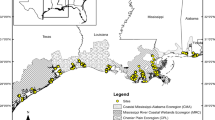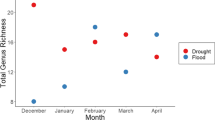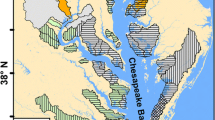Abstract
A procedure was developed using aboveground field biomass measurements of Chesapeake Bay submersed aquatic vegetation (SAV), yearly species identification surveys, annual photographic mapping at 1∶24,000 scale, and geographic information system (GIS) analyses to determine the SAV community type, biomass, and area of each mapped SAV bed in the bay and its tidal tributaries for the period of 1985 through 1996. Using species identifications provided through over 10,000 SAV ground survey observations, the 17 most abundant SAV species found in the bay were clustered into four species associations: ZOSTERA, RUPPIA, POTAMOGETON, and FRESHWATER MIXED. Monthly aboveground biomass values were then assigned to each bed or bed section based upon monthly biomass models developed for each community. High salinity communities (ZOSTERA) were found to dominate total bay SAV aboveground biomass during winter, spring, and summer. Lower salinity communities (RUPPIA, POTAMOGETON, and FRESHWATER MIXED) dominated in the fall. In 1996, total bay SAV standing stock was nearly 22,800 metric tons at annual maximum biomass in July encompassing an area of approximately 25,670 hectares. Minimum biomass in December and January of that year was less than 5,000 metric tons. SAV annual maximum biomass increased baywide from lows of less than 15,000 metric tons in 1985 and 1986 to nearly 25,000 metric tons during the 1991 to 1993 period, while area increased from approximately 20,000 to nearly 30,000 hectares during that same period. Year-to-year comparisons of maximum annual community abundance from 1985 to 1996 indicated that regrowth of SAV in the Chesapeake Bay from 1985–1993 occurred principally in the ZOSTERA community, with 85% of the baywide increase in biomass and 71% of the increase in are a occurring in that community. Maximum biomass of FRESHWATER MIXED SAV beds also increased from a low of 3,200 metric tons in 1985 to a high of 6,650 metric tons in 1993, while maximum biomass of both RUPPIA and POTAMOGETON beds fluctuated between 2,450 and 4,600 metric tons and 60 and 600 metric tons, respectively, during that same period with net declines of 7% and 43%, respectively, between 1985 and 1996. During the July period of annual, baywide, maximum SAV biomass, SAV beds in the Chesapeake Bay typically averaged approximately 0.86 metric tons of aboveground dry mass per hectare of bed area.
Similar content being viewed by others
Literature Cited
Batiuk, R. A., R. J. Orth, K. A. Moore, W. C. Dennison, J. C. Stevenson, L. Staver, V. Carter, N. Rybicki, R. E. Hickman, S. Kollar, S. Bieber, P. Heasly, andP. Bergstrom. 1992. Submerged aquatic vegetation habitat requirements and restoration targets: A technical synthesis. CBP/TRS 83/92. U.S. Environmental Protection Agency, Annapolis, Maryland.
Boesch, D. F. 1977. Application of numerical classification in ecological investigations of water pollution. United States Environmental Protection Agency Ecological Research Series. EPA-600/3-77-033. Corvallis, Oregon.
Boumans, R. M. J. andF. H. Sklar. 1990. A polygon-based spatial (PBS) model for simulating landscape change.Landscape Ecology 4:83–97.
Bulthuis, D. A. 1995. Distribution of seagrasses in a North Puget Sound estuary: Padilla Bay, Washington.Aquatic Botany 50: 99–105.
Carter, V. andN. B. Rybicki. 1985. The effects of grazers and light penetration on the survival of transplants ofVallisneria americana Michx in the tidal Potomac River, Maryland.Aquatic Botany 23:197–213.
Carter, V. andN. B. Rybicki. 1986. Resurgence of submersed aquatic macrophytes in the tidal Potomac River, Maryland, Virginia, and the District of Columbia, 1986.Estuaries 9:368–375.
Carter, V., N. B. Rybicki, J. M. Landwehr, andM. Turtora. 1994. Role of weather and water quality on population dynamics of submersed macrophytes in the tidal Potomac River.Estuaries 17:417–426.
Cerco, C. andT. Cole. 1994. Three-dimensional eutrophication model of Chesapeake Bay.Journal of Environmental Engineering 119:1006–1025.
Chesapeake Research Consortium (CRC). 1975. The effects of tropical storm Agnes on the Chesapeake Bay estuarine system. CRC Publication No. 54. The Johns Hopkins University Press, Baltimore, Maryland.
Clifford, H. T. andW. Stevenson. 1975. An Introduction to Numerical Classification. Academic Press, New York.
Coles, R. G., W. J. L. Long, R. A. Watson, andK. J. Derbyshire. 1993. Distribution of seagrasses, and their fish and penaeid prawn communities, in Cairns harbour, a tropical estuary, Northern Queensland, Australia.Australian Journal of Marine and Freshwater Research 44:193–210.
Costanza, R., F. H. Sklar, andM. L. White. 1990. Modeling coastal landscape dynamics.BioScience 40:91–107.
Dennison, W. C., R. J. Orth, K. A. Moore, J. C. Stevenson, V. Carter, S. Kollar, P. Bergstrom, andR. Batiuk. 1993. Assessing water quality with submersed aquatic vegetation.Bioscience 43:86–94.
Ferguson, R. L. andK. Korfmacher. 1997. Remote sensing and GIS analysis of seagrass meadows in North Carolina, USA.Aquatic Botany 58:241–258.
Fredette, T. J., R. J. Diaz, J. van Montfrans, andR. J. Orth. 1990. Secondary production within a seagrass bed (Zostera marina andRuppia maritima) in lower Chesapeake Bay.Estuaries 13:431–440.
Haramis, G. M. andV. Carter. 1983. Distribution of submersed aquatic macrophytes in the tidal Potomac River.Aquatic Botany 15:65–79.
Kilgore, K. J., R. P. Morgan, II, andN. B. Rybicki. 1989. Distribution and abundance of fishes associated with submersed aquatic plants in the Potomac River.North American Journal of Fisheries Management 9:101–111.
Larkum, A. W. D. andR. J. West. 1990. Long-term changes of seagrass meadows in Botany Bay, Australia.Aquatic Botany 37: 55–70.
Lehmann, A. andJ.-B. Lachavanne. 1997. Geographic information systems and remote sensing in aquatic botany.Aquatic Botany 58:195–207.
Lubbers, L., W. R. Boynton, andW. M. Kemp. 1990. Variations in structure of estuarine fish communities in relation to abundance of submersed vascular plants.Marine Ecology Progress Series 65:1–14.
Moore, K. A., J. L. Goodman, J. C. Stevenson, L. Murray, andK. Sundberg. 1995. Chesapeake Bay nutrients, light, and SAV: Relationships between water quality and SAV growth in field and mesocosm studies. Final Report. U.S. Environmental Protection Agency, Chesapeake Bay Program, Annapolis, Maryland.
Moore, K. A., H. A. Neckles, andR. J. Orth. 1996.Zostera marina (eelgrass) growth and survival along a gradient of nutrients and turbidity in the lower Chesapeake Bay.Marine Ecology Progress Series 142:247–259.
Naylor, P. andM. Kazyak. 1995. Quantitative characterization of submerged aquatic vegetation species in tidal freshwater reaches of the Patuxent River drainage basin. Final Report, Maryland Department of the Environment. Annapolis, Maryland.
Nichols, L., R. R. Anderson, W. C. Banta, E. J. Forman, andS. H. Boutwell. 1979. Evaluation of the effects of the thermal discharge on the submerged aquatic vegetation and associated fauna in the vicinity of the C.P. Crane Generating Station. Final Report. Maryland Department of Natural Resources, Annapolis, Maryland.
Orth, R. J., R. A. Batiuk, and J. F. Nowak. 1994. Trends in the distribution and abundance of habitat quality of submerged aquatic vegetation in Chesapeake Bay and its tidal tributaries: 1971 to 1991. U.S. Environmental Protection Agency, Chesapeake Bay Program Office. CBP/TRS 137/95. Annapolis, Maryland.
Orth, R. J. andK. A. Moore. 1981. The biology and propagation ofZostera marina, eelgrass, in the Chesapeake Bay. Special Report 265 in Applied Marine Science, and Ocean Engineering. Virginia Institute of Marine Science. Gloucester Point, Virginia.
Orth, R. J. andK. A. Moore. 1983. An unprecedented decline in submerged aquatic vegetation (Chesapeake Bay).Science 22:51–53.
Orth, R. J. andK. A. Moore. 1984. Distribution and abundance of submerged aquatic vegetation in Chesapeake Bay: An historical perspective.Estuaries 7:531–540.
Orth, R. J. andK. A. Moore. 1986. Seasonal and year-to-year variations in the growth ofZostera marina L. (eelgrass) in the lower Chesapeake Bay.Aquatic Botany 24:335–341.
Orth, R. J. andK. A. Moore. 1988. Distribution ofZostera marina andRuppia maritima sensu lato along depth gradients in the Lower Chesapeake Bay, U.S.A.Aquatic Botany 32:291–305.
Orth, R. J., J. F. Nowak, G. F. Anderson, andJ. R. Whiting. 1997. Distribution of submerged aquatic vegetation in the Chesapeake Bay and tributaries and Chincoteague Bay—1996. Final Report. U.S. Environmental Protection Agency, Chesapeake Bay Program Office. Annapolis, Maryland.
Orth, R. J., J. Nowak, A. Frisch, K. Kiley, andJ. Whiting. 1991. Distribution of submerged aquatic vegetation in the Chesapeake Bay and tributaries and Chincoteague Bay—1990 Final Report. U.S. Environmental Protection Agency, Chesapeake Bay Program Office. Annapolis, Maryland.
Paine, D. P. 1981. Aerial Photography and Image Interpretation for Resource Management. John Wiley & Sons, Inc. New York.
Pulich, W. M. 1985. Seasonal growth dynamics ofRuppia maritima L.s.l. andHalodule wrightii aschers, in southern Texas and evaluation of sediment fertility status.Aquatic Botany 23:53–66.
Robbins, B. D. 1997. Quantifying temporal change in seagrass areal coverage: The use of GIS and low resolution aerial photography.Aquatic Botany 58:259–267.
Rybicki, N. B., R. T. Anderson, and V. Carter. 1988. Data on the distribution and abundance of submersed aquatic vegetation in the tidal Potomac River and transition zone of the Potomac estuary, Maryland, Virginia, and the District of Columbia, 1987. U.S. Geological Survey Open-File Report 88-307.
Rybicki, N. B. andV. Carter. 1995. Revegetation and propagule transport in the tidal Potomac River, p. 201–218.In Proceedings, 29th Annual Meeting Aquatic Plant Control Program. U.S. Corps of Engineers, Vicksburg, Mississippi.
Rybicki, N. B., V. Carter, R. T. Anderson, and T. J. Trombley. 1995.Hydrilla verticillata in the tidal Potomac River, Maryland, Virginia, and the District of Columbia, 1983 and 1984: U.S. Geological Survey Open-File Report 85-77.
Sand-Jensen, K. 1975. Biomass, net production and growth dynamics in an eelgrass (Zostera marina L.) population in Vellerup Vig, Denmark.Ophelia 14:185–201.
Staver, L. W. 1986. Competitive interactions of submerged aquatic vegetation under varying nutrient and salinity conditions. M.S. Thesis, University of Maryland. College Park, Maryland.
Stevenson, J. C. and N. M. Confer. 1978. Summary of available information on Chesapeake Bay vegetation. U.S. Fisheries and Wildlife Service Report. FWS/OBS-78/66. Annapolis, Maryland.
Stevenson, J. C., L. Staver, andK. W. Staver. 1993. Water quality associated with survival of submerged aquatic vegetation along an estuarine gradient.Estuaries 16:346–361.
Zieman, J. C., J. W. Fourqurean, andR. L. Iverson. 1989. Distribution, abundance and productivity of seagrasses and macroalgae in Florida Bay.Bulletin of Marine Science 44:292–311.
Sources of Unpublished Materials
Carter, V. unpublished data. U.S. Geological Survey, 430 National Center, Reston, Virginia 22092.
Rybicki, N. unpublished data. U.S. Geological Survey, 430 National Center, Reston, Virginia 22092.
Staver, L. unpublished data. Center for Environmental and Estuarine Studies, University of Maryland, Horn Point Laboratory, P.O. Box 775, Cambridge, Maryland 21613.
Author information
Authors and Affiliations
Corresponding author
Rights and permissions
About this article
Cite this article
Moore, K.A., Wilcox, D.J. & Orth, R.J. Analysis of the abundance of submersed aquatic vegetation communities in the Chesapeake Bay. Estuaries 23, 115–127 (2000). https://doi.org/10.2307/1353229
Received:
Accepted:
Issue Date:
DOI: https://doi.org/10.2307/1353229




